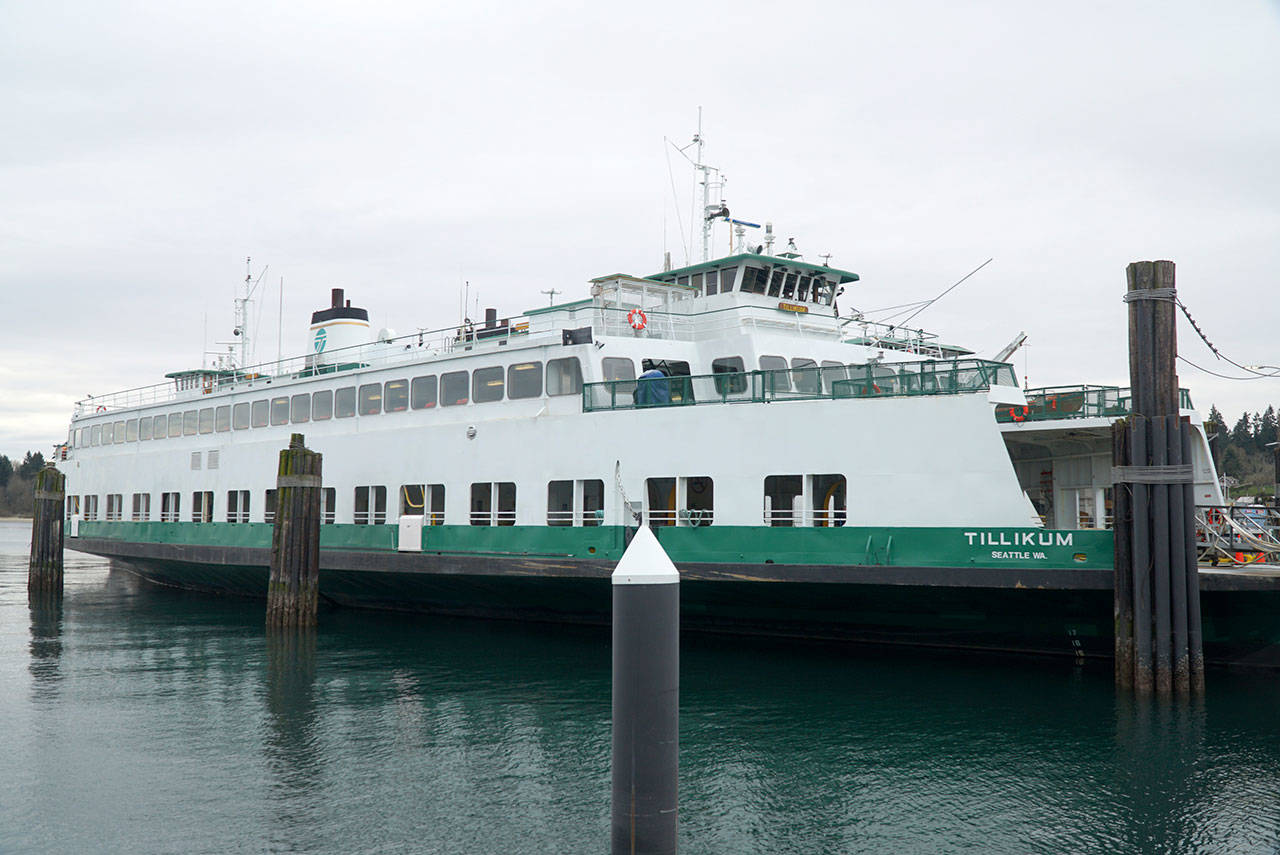Back in 1959, when the Washington State Ferries’ M/V Tillikum first put to sea on the Bainbridge Island/Seattle route, both Alaska and Hawaii were new states, gas cost 25 cents a gallon, and in Cuba Fidel Castro ascended just as in Iowa a plane plummeted, killing Buddy Holly, Ritchie Valens and The Big Bopper, ending the golden age of American rock and roll.
A lot has changed, both at home and abroad. And it seems sometimes that nothing is what is used to be.
Nothing, that is, except the Tillikum.
The longest running in-service vessel in the WSF fleet was recognized at a special historic ceremony Wednesday, Feb. 27 at Eagle Harbor Maintenance Facility, when the first ever 60 years’ service emblem, which will hang above the car deck on each end of the ferry until it is utlimately retired in 2023, was unveiled and awarded by WSF Assistant Secretary Amy Scarton. In attendance were the boat’s captain, crew and shipyard workers, many who contributed greatly to its longevity, among others.
Though the boat may wear the award, she said, the achievement belongs to the people.
“Today’s event is really about all of you,” Scarton said. “I am specifically here today to thank the men and woman of Washington State Ferries for all of your hard work in keeping this vessel running.
“It is the skill, it’s the training, it’s the work force that makes, not just this vessel a great asset to the people of Washington State, but it makes our entire system run.”
WSF’s recently completed the first long range plan in a decade, which plots the future of the ferry system through 2040, and specifically identified “aging vessels” as a key challenge going forward. All but 13 of the state’s boats are more than 30 years old, but even within those parameters the Tillikum is, ahem, a classic.
The Tillikum, which has since 2017 served as chief inter-island ferry between the San Juan Islands, was christened on Nov. 10, 1958, one of the first vessels to be built especially for the newly created WSF. It was first put into service on the Bainbridge Island/Seattle route, where it remained until 1968 (it was replaced by the M/V Elwha).
Tillikum was the last of the three Evergreen State-class boats constructed, and is the last of the class still in service.
The eldest, Evergreen State, remained active until November 2015, when it was retired. The middle boat, Klahowya, having itself been replaced as the inter-island vessel in the San Juan Islands by Tillikum, currently resides dockside at the Eagle Harbor facility awaiting final disposal.
It is 310-feet, 2-inches long, capable of speeds up to 13 knots, and able to transport 87 vehicles and about 1,000 passengers.
The word Tillikum means “friends and relatives” in Chinook dialect, and the boat has received care in keeping with its name from the WSF crew, Scarton said.
“The Tillikum is a testament to the sheer love and dedication of our engineers, Eagle Harbor staff, and crews,” Scarton said. “While the Tillikum remains a reliable vessel, we can’t continue to use technology of the 1950s for today’s needs. I look forward to working with the legislature to secure funding to replace the 13 vessels due for retirement in the next 20 years.”
Present at the ceremony to share his own experiences as a young sailor aboard the Tillikum was longtime island resident and Bainbridge High School grad Captain Jamie Pelland, who began work as the WSF North Regional Port Captain earlier in the week after 40 years spent working in nearly every possibly seagoing position in the fleet.
“I’ve worked for WSF for going on 41 years,” he said. “I started as an ordinary Seaman and worked my way up to Master. When I started working here I was 20-years, and I first started working on this boat when I was 22. And this boat was 20-years old when I started. I like to say we’ve aged together.
“It’s done a great job keeping our communities together for over 60 years and that’s what we need,” he added.
In his new role Pelland is responsible for ensuring proper manning for every vessel north of Kingston – Kingston, Port Townsend, Mukilteo, Anacortes – and knows very well, from his own days on deck, how much pride crew members take in keeping boats like the Tillikum shipshape.
“The crews that work these boats, they put their heart into trying to keep the boats up,” he said.
Ian Sterling, WSF Director of Communications, agreed that passion was the key to the Tillikum’s endurance.
“There’s a reason these things are able to run for 60 years, and that’s much beyond what most ferry systems get out of their ferries,” he said. “If you look at Norway and that type of [place], maybe 20 years is more realistic. So, to get a boat to 60 years is spectacular and these guys, I think they’d keep them running forever if the could but finding people to work on them, parts all of that kind of thing gets tougher and tougher.
“It’s been a real workhorse for the people of this state,” Sterling added. “It’s one of our real reliable vessels, actually. But it’s not a modern vessel. [It has] surplus motor parts from a World War II destroyer, so we’re talking 1940s technology that’s in this thing and it just can’t keep up with the demands of a modern ferry system, especially the speed. It’s a much slower vessel than most of our others.”



